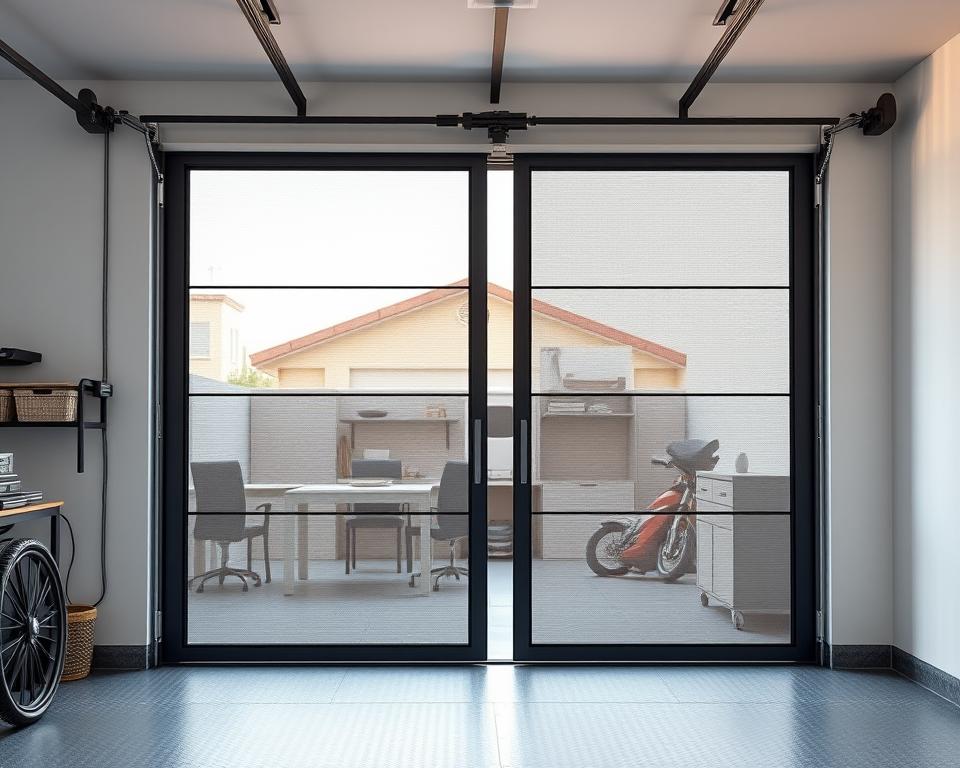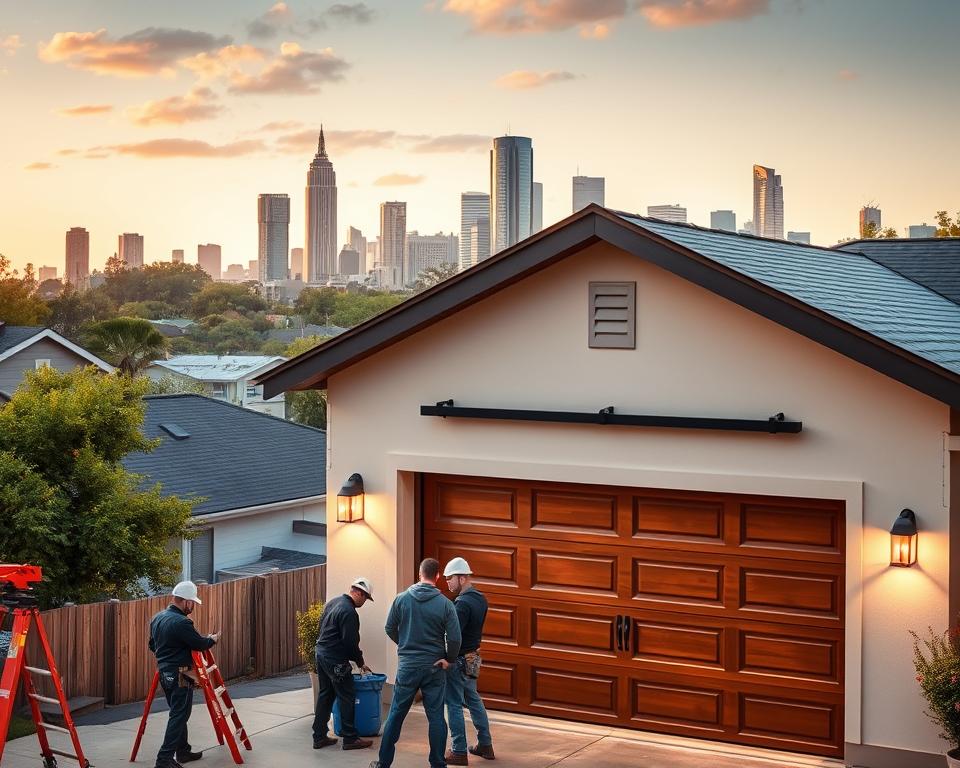Garage Door Spring Restoration in Aliso Viejo – Expert Solutions
Have you ever reflected on how heavily you depend on your garage door? What if its springs abruptly broke? Here at Coastline Garage Doors, we offer first-rate garage door spring repair in Aliso Viejo to guarantee your door works smoothly and safely. Our proficient technicians are specialists in both torsion and extension springs, keeping your home or business secure. Ignoring garage door panel repair can result in more than merely discomfort; it can also pose hazards.
Our rapid and trustworthy garage door spring restoration service in Aliso Viejo ensures that you’re never left without assistance. We also provide emergency garage door spring restoration in Aliso Viejo for those sudden moments.
Major Highlights
- Recognizing the significance of garage door springs for security and convenience.
- Coastline Garage Doors specializes in rapid and proficient fixes.
- Skilled technicians are prepared to address both torsion and extension springs.
- Emergency repair services confirm your door is repaired when you require immediate assistance.
- Regular maintenance can prevent pricey repairs down the road.
Grasping Garage Door Springs
Garage door springs are critical for the efficient operation of garage doors. They store and release energy, counteracting the door’s mass against gravity. Understanding their mechanics is key for homeowners. Torsion springs, located above the door, employ torque to raise it. Extension springs, positioned on the flanks, offset the door’s mass.
Periodic maintenance is crucial for their longevity. A swift garage door spring adjustment Aliso Viejo can avert expensive issues. Homeowners should observe their garage door’s operation. Recognizing when to replace garage door torsion springs Aliso Viejo is essential. Anticipatory spring care extends the life of the garage door system.
Signs You Need Garage Door Spring Repair
Property owners should be watchful for signals that indicate the necessity for garage door spring repair. Early intervention can prevent additional harm and enhance safety. Identifying these clues ensures timely assistance from Aliso Viejo garage door spring specialists.
Unusual Noises During Functioning
Odd noises from your garage door might signal spring issues. Resounding banging or persistent squeaking frequently hint at malfunctioning springs. These sounds are a definite warning that requires instant action. Ignoring them could result in more severe problems.
Uneven Door Motion
Uneven door movement is an additional important sign. If the garage door pauses, lags, or moves irregularly, it might indicate a defective spring system. Such actions not only complicates access but also poses a risk of incidents. For trustworthy garage door spring repair near me Aliso Viejo, contact local experts who can assess and repair the problem promptly.

Types of Garage Door Springs
Grasping the varieties of garage door springs is essential for those contemplating garage door spring setup in Aliso Viejo. There are two main types: torsion springs and extension springs. Each has its own role, suiting different door styles and mass.
Torsion Springs Explained
Torsion springs sit over the garage door, applying torque to raise and shut it. They are ideal for weightier doors, including commercial ones. These springs deliver a smoother operation, minimizing wear on the door system. Their robust design also ensures they last longer, which is vital for garage door spring replacement services.
Proper installation of torsion springs is essential for security and operation.
Grasping Extension Springs
Extension springs are located on either side of the garage door, utilizing tension to assist it operate. They stretch when the door shuts and contract when it lifts. While they’re easier to install and more affordable, they might need more periodic upkeep. Choosing the appropriate spring type can significantly affect your garage door’s functionality and lifespan.
Knowing the difference assists property owners in deciding between garage door spring installation in Aliso Viejo and regular maintenance services.
Significance of Professional Garage Door Spring Repair
Selecting a qualified garage door spring repair service Aliso Viejo delivers notable benefits to homeowners. Garage door springs are subjected to immense tension, presenting a risk if not managed correctly. Any effort at repair or substitution without proper training can be hazardous, resulting in serious injury or expensive damage.
Coastline Garage Doors has experienced technicians with a comprehensive understanding of various spring systems. Their expertise guarantees that garage door spring repair in Aliso Viejo is conducted seamlessly and successfully. By relying on qualified professionals, customers can anticipate both safety and acceptable outcomes.
Experts also use high-quality materials that improve durability and longevity. This focus to quality lowers the probability of future issues and supports extended savings. Customers can have confidence in that the work will withstand wear and tear, safeguarding their asset.
For individuals seeking a trustworthy solution for their garage door spring problems, professional services are indispensable. Emphasizing safety, efficiency, and quality, hiring experts ensures that the garage door functions seamlessly. It also mitigates risks stemming from spring failures.
Garage Door Spring Restoration in Aliso Viejo
Coastline Garage Doors is your top choice for professional garage door spring repair in Aliso Viejo. Our customized services guarantee that your garage door operates safely and effectively. We know how crucial it is to tackle garage door issues promptly. That’s why our garage door spring repair service in Aliso Viejo is designed for swift and trustworthy responses.
Our team excels in repairing a diverse range of garage door types and brands, focusing on both performance and safety. Whether you’re dealing with a damaged spring or needing a full replacement, our technicians are ready to assist. Customer satisfaction is our highest priority. We aim to provide lasting solutions that keep your garage door running seamlessly.
Reasons for Spring Failure
Garage door springs are vital for your door’s function. Their failure can cause major problems. Knowing why springs fail helps homeowners prevent issues.
Wear and Tear from Regular Use
Daily use exerts considerable stress on garage door springs. Numerous systems operate multiple times a day, leading to wear and tear. This constant use diminishes springs, causing them to deteriorate and fail. It’s crucial to check for signs of wear early to stop failure. Consider obtaining garage door spring repair near me Aliso Viejo to maintain your system in top condition.
Weather-Related Effects on Springs
Environmental factors can damage your garage door springs. Severe temperatures, high humidity, and rust can damage them. Changing weather can also place stress on springs as metal stretches and shrinks. Regular garage door extension spring repair Aliso Viejo can assist in combating these environmental challenges. Protecting your springs not only extends their life but also ensures your garage door working well.
Garage Door Spring Replacement Services
Coastline Garage Doors delivers top-notch garage door spring replacement services. We cater to various needs and situations. Our proficient technicians are ready to manage both new garage door spring installation Aliso Viejo and emergency garage door spring repair Aliso Viejo. A well-operating garage door is vital for safety and ease. Timely repairs and installations are imperative.
New Garage Door Spring Setup
Installing a new garage door spring requires accuracy and expertise. Our team follows strict safety protocols during the setup. We specialize in both torsion and extension springs. With high-premium materials and attentive care, our installations boost functionality and longevity.
Emergency Garage Door Spring Repair
Garage door problems can occur unexpectedly. Our emergency garage door spring repair Aliso Viejo services provide quick assistance. We understand the critical nature of a malfunctioning garage door. Our team is always ready to address issues swiftly, ensuring you restore access without delay.
Cost of Garage Door Spring Repair in Aliso Viejo
The price of garage door spring repair in Aliso Viejo is dependent on multiple factors. The type of spring requiring repair is a major factor. Torsion springs necessitate a more complex installation than extension springs, affecting the price. The degree of the spring damage also influences the cost. Small issues might merely need tweaks, while severe damage could require a full spring replacement.
Labor costs are another vital consideration. Seasoned technicians, like those at Coastline Garage Doors, charge based on the job’s complexity and time. It’s essential to have transparent pricing. Coastline Garage Doors offers free estimates, so that clients know all costs before work commences.
Investing in high-quality garage door spring repair in Aliso Viejo boosts functionality and extends the door’s lifespan. This preventative approach can reduce expenses in the long run by minimizing the need for additional repair or replacement.
| Type of Repair | Approximate Cost |
|---|---|
| Torsion Spring Substitution | $200 – $300 |
| Extension Spring Substitution | $150 – $250 |
| Spring Adjustment | $100 – $150 |
| Emergency Restoration Services | $250 – $400 |
Why Choose Coastline Garage Doors for Spring Repairs?
Coastline Garage Doors is the top choice for garage door spring repair service Aliso Viejo. Our team of experts is focused on delivering first-rate service. We use advanced tools and methods to quickly detect and fix any issues, guaranteeing your safety and contentment.
We are dedicated to using only the highest-quality parts, guaranteeing your garage door functions smoothly for years. Our pricing is straightforward, with no hidden fees. Residents in Aliso Viejo depend on us for reliable repairs and outstanding customer service.
Garage Door Spring Tweak Explained
Modifying garage door springs is vital for preserving your door’s functionality and security. It’s crucial to keep the correct tension, as erroneous adjustments can result in problems. If the tension is off, the door might fail to open smoothly or become stuck. Conversely, too much tension can exert strain on the door and its components, leading to damage or injury.
Understanding how garage door springs function is crucial to their proper operation. Without the correct adjustment, the door performs poorly, accelerating wear on other components. Coastline Garage Doors excels in modifying garage door springs in Aliso Viejo. We guarantee your door operates effectively and securely, regardless of the type.
Customer Testimonials and Success Stories
Feedback from our customers demonstrates Coastline Garage Doors as the top Aliso Viejo garage door spring experts. Many have revealed their favorable experiences, highlighting our rapid and effective garage door spring repair service Aliso Viejo. Our technicians are lauded for their professionalism and swift issue resolution.
Success stories underscore our commitment to customer satisfaction. For instance, one customer noted how we swiftly addressed an critical spring failure. We recovered their garage door’s operation in just a few hours. Such feedback solidifies our reputation, proving our role in providing assurance during unexpected situations.
These testimonials attest to the excellence of workmanship and the commitment of our team. Coastline Garage Doors stands out as the top choice for homeowners in search of reliable garage door spring solutions.
Timing for Your Garage Door Spring Inspection
Routine inspections are crucial to extending your garage door springs’ durability. property owners should watch for signs of wear, such as odd noises or irregular door movement. Ignoring these signs can lead to more significant problems later.
Annual maintenance check-ups are recommended, during which the springs are comprehensively inspected for wear and modified as needed. Coastline Garage Doors urges residents of Aliso Viejo to schedule inspections. This proactive approach helps detect early problems and ensures your garage door functions securely and reliably.
In Summary
Coastline Garage Doors is dedicated to delivering top-notch garage door spring repair services in Aliso Viejo. It’s essential to understand the role and significance of your garage door springs for their longevity and your safety. Detecting signs of wear, like odd noises or uneven movement, assists property owners tackle problems early.
Our commitment to quality, dependability, and happiness guarantees your garage door remains secure and functional. Whether it’s routine inspections or emergency repairs, our experienced team is ready to help. For any garage door spring repair needs in Aliso Viejo, contact us to enjoy our outstanding service.
Caring for your garage door springs is critical for their longevity and your system’s efficiency. Trust Coastline Garage Doors for all your garage door spring repair service needs in Aliso Viejo. We’re here to ensure your garage door operates smoothly.









